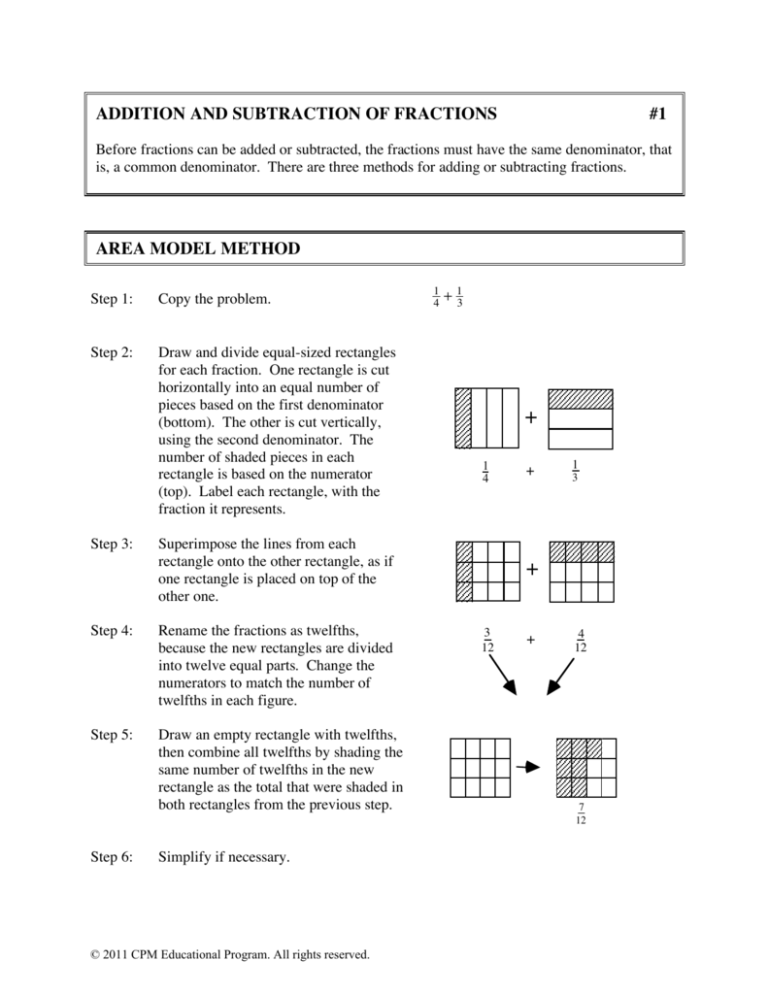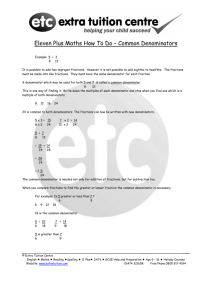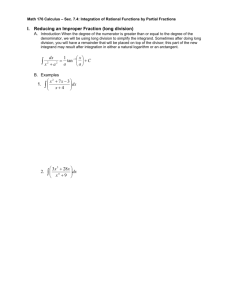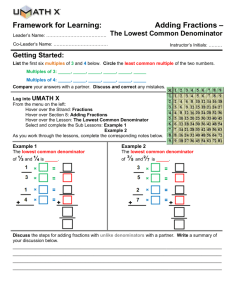
ADDITION AND SUBTRACTION OF FRACTIONS
#1
Before fractions can be added or subtracted, the fractions must have the same denominator, that
is, a common denominator. There are three methods for adding or subtracting fractions.
AREA MODEL METHOD
Step 1:
Copy the problem.
Step 2:
Draw and divide equal-sized rectangles
for each fraction. One rectangle is cut
horizontally into an equal number of
pieces based on the first denominator
(bottom). The other is cut vertically,
using the second denominator. The
number of shaded pieces in each
rectangle is based on the numerator
(top). Label each rectangle, with the
fraction it represents.
Step 3:
+ 13
+
1
4
Superimpose the lines from each
rectangle onto the other rectangle, as if
one rectangle is placed on top of the
other one.
Step 4:
Rename the fractions as twelfths,
because the new rectangles are divided
into twelve equal parts. Change the
numerators to match the number of
twelfths in each figure.
Step 5:
Draw an empty rectangle with twelfths,
then combine all twelfths by shading the
same number of twelfths in the new
rectangle as the total that were shaded in
both rectangles from the previous step.
Step 6:
1
4
Simplify if necessary.
© 2011 CPM Educational Program. All rights reserved.
+
1
3
+
3
12
+
4
12
–7
12
Example 1
1
2
+
+
1
5
can be modeled as:
1
5
1
2
+
1
2
+
2
+ 10
=>
so
7
10
2
10
5
10
Thus,
5
10
1
5
7
= 10
.
Example 2
3
4
+
3
5
would be:
3
4
+
=>
+
15
20
3
5
27 = 1 7
20
20
12
20
Problems
Use the area model method to add the following fractions.
1
4
1.
+
1
5
2
3
2.
+
1
7
+
3.
1
3
3.
7
12
Answers
1.
9
20
2.
17
21
© 2011 CPM Educational Program. All rights reserved.
+
=>
1
4
IDENTITY PROPERTY OF MULTIPLICATION (Giant 1) METHOD
The Giant One, known in mathematics as the Identity Property of Multiplication, uses a
fraction with the same numerator and denominator ( 33 , for example) to write an equivalent
fraction that helps to create common denominators.
Example
Add
+
2
3
1
4
using the Giant One.
Step 1:
Step 2:
Multiply both 23 and 14 by Giant Ones
to get a common denominator.
2
3
8 + 3
! 44 + 14 ! 33 = 12
12
Add the numerators of both fractions
to get the answer.
8
12
11
+ 123 = 12
RATIO TABLE METHOD
The least common multiple, that is, the smallest positive integer divisible by both (or all)
of the denominators, is found by using ratio tables. The least common multiple is used as the
common denominator of the fractions. The Giant One or another ratio table can be used to
find the new numerators.
Example
Solve
3
4
!
1
6
using a ratio table to find the least common denominator of the fractions.
Use a ratio table to find the least common
denominator of the fractions. (This is the
same as finding the least common
multiple of the denominators, 4 and 6.)
You then use the Giant
One to find the new
numerator.
3
4
!
1
6
"
3
4
4
8 12 16
6 12 18 24
#
© 2011 CPM Educational Program. All rights reserved.
3
3
!
1
6
#
2
2
"
9
12
2
! 12
"
7
12
Problems
Find each sum or difference. Use the method of your choice.
1.
1
3
+
3
5
2.
5
6
5.
3
9
+
3
4
6.
5
12
9.
5
8
+
3
8
10.
1
4
+
13.
5
7
! 13
14.
3
4
!
17.
2
3
!
18.
3
5
9
! 15
3
4
+ 13
3.
5
9
! 13
4.
1
4
+
5
7
+
7.
4
5
!
2
3
8.
3
4
!
2
5
2
3
11.
1
6
+
2
3
12.
7
8
+
3
4
2
3
15.
4
5
+
1
4
16.
6
7
!
3
4
19.
4
5
!
2
3
20.
4
6
! 11
23
2
3
Answers
1.
14
15
6.
13
12
1
= 1 12
2.
7
6
7.
2
15
= 1 16
= 1 58
11.
5
6
12.
13
8
16.
3
28
17.
1
! 12
3.
2
9
4.
27
28
8.
7
20
9.
49
40
13.
8
21
14.
19.
18.
0
39
36
10.
11
12
1
12
15.
21
20
2
15
20.
! 123 = !
9
= 1 40
To summarize addition and subtraction of fractions:
1.
Rename each fraction with equivalents that have a common denominator.
2.
Add or subtract only the numerators, keeping the common denominator.
3.
Simplify if possible.
© 2011 CPM Educational Program. All rights reserved.
3 =1 1
= 1 36
12
5.
1
= 1 20
1
4
SUBTRACTING MIXED NUMBERS
To subtract mixed numbers, change the mixed numbers into fractions greater than one, find a
common denominator, then subtract.
Example
2 15
Find the difference: 2 15 ! 1 43 .
= 11 · 3 = 33
2
– 13
5
3
15
5·
3
5
5
= 15
25
8
15
Problems
Find each difference.
1.
2 18 ! 1 43
4.
4
3
4
!2
4
5
2.
4 13 ! 2 63
3.
1 16 !
5.
6 ! 1 25
6.
4 18 ! 1 23
3
5
Answers
!
7
4
!
17
8
!
! 14
8
1.
17
8
3.
7
6
!
3
5
!
35
30
!
! 18
30
5.
6
1
!
7
5
!
30
5
!
7
5
!
3
8
2.
13
3
!
! 15
6
!
! 15
6
17
30
4.
19
4
!
! 14
5
95
20
6.
33
8
!
23
5
or 4
3
5
© 2011 CPM Educational Program. All rights reserved.
5
3
!
99
24
!
!
56
20
40
24
11
6
!
!
or 1 56
39
20
59
24
or
19
20
11
or 2 24








